

Julia Downing - NanoJapan 2015
University of Maryland, College Park
Major: Materials Science & Engineering and Project Management
Class Standing: Sophomore
Anticipated Graduation: May 2018
NanoJapan Research Lab: Profs. Koichiro Tanaka & Takashi Arikawa, Solid State Spectroscopy Group, Kyoto University
NanoJapan Research Project: ![]()
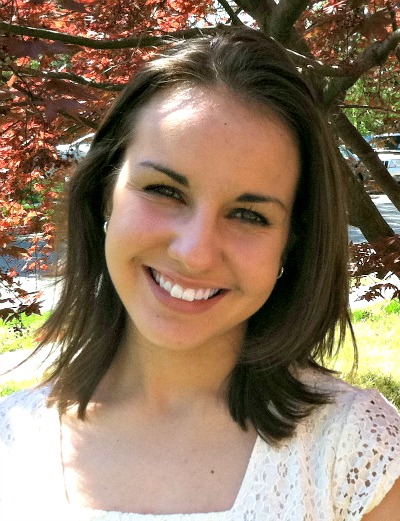
Why NanoJapan?
To me, NanoJapan provides a unique opportunity for engineering and physics students who are new to research because it presents the perfect package of academia, cultural discovery, and adventure. It offers exposure to the cutting-edge field of nanotechnology and THz research while also providing students with a cross-cultural education, which is absolutely essential for the next generation of scientists. The American paradigm for research is inherently limited in scope, as many modern design challenges have grown too large to be tackled by one nation alone. NanoJapan promotes international collaboration between the world’s leading innovators, which I believe will pave the way to a new age of discovery.
I applied to NanoJapan because I wanted to enrich my undergraduate research experience with an added layer of international collaboration and mentorship. I believe NanoJapan will enable me to adopt a global view when approaching science and engineering problems in my career and liberate me from a linear path of thinking. I also hope that my experience at my host lab will inform my research interests for graduate studies, give me the opportunity to establish solid research skills as an undergraduate, and make me a better contributor to my current and future teams both domestically and internationally. I am very much looking forward to learning the Japanese language and practicing with my new friends and lab-mates. I pursued engineering because I truly enjoy working with others, and I am excited to explore Japanese culture with my colleagues. Finally, I am eager to travel through Japan’s beautiful landscape and visit as many of its historic cultural sites as I can.
My goals for this summer are to:
Meaning of NanoJapan - Post-Program
NanoJapan is so much more than an internship, or a research experience, or a study abroad program. It somehow manages to combine the best elements of all of these to produce an experience that has the power to foster unprecedented academic, cultural, and professional growth in an individual. This program has given me countless new skills to equip me for a future in research and international collaborations, along with beautiful memories in one of the most unique countries on Earth with people that have brought out the best in me. It definitely wasn’t easy, but I wouldn’t change a minute of my experience. Every mistake, big and small, both in and out of the lab taught me something new and broadened my perception of what it means to be a student, a scientist, and a global citizen.
Research Internship Overview
My academic background is in materials science and engineering, so I was not a stranger to solid-state physics before this program. However, I was definitely intimidated by the amount of theory I would have to learn to understand my project once I arrived! My project basically utilized absorption spectroscopy to probe low-energy carrier dynamics of single-wall carbon nanotubes (SWCNT) of different types (semiconducting and metallic) in an effort to identify nonlinear responses to strong terahertz radiation such as harmonic generation, absorption saturation and induced transparency in the SWCNT films. These prototypical 1D-materials systems offered a solid foundation for a new generation of optoelectronic devices. My project aligned pretty well with my previous research experience and interest in nanomaterials, but my knowledge of the field has increased dramatically after this experience. NanoJapan has solidified my desire to study materials or electrical engineering in a doctoral program after I graduate, and I would like to continue study of the nano regime. The experience of working in an international setting also gave me valuable insight as a global researcher, and I definitely want to incorporate international collaboration into my future career in research by living and working abroad long-term after I leave graduate school.
My lab environment was very welcoming and the days I spent working there were very happy. The time went by very quickly because I was really excited about my research and the work I had to do. I worked in a large office with the other graduate students and my mentor, Arikawa-sensei. I think Arikawa-sensei and I had a very good working dynamic; he was very patient when I had rudimentary questions, and was always willing to spend time with me when I met challenges during the project. We spent hours taking measurements towards the end of the project and I’m very grateful to him for being so generous with his time. I cannot believe how much I learned from him over the course of just 8 weeks!
Even if everyone was working and the room was quiet, I still enjoyed the whole group being together. My lab began to feel like a family as I became friends with some of my lab-mates, and I loved the activities we did together as a group. Unlike some of the other groups, our group got lunch together almost every day which was a great opportunity to chat outside of the office and practice my Japanese skills. We also hiked Daimonji, a nearby mountain, as a group and got dinner or made other plans on the weekends. I would not have had half of my wonderful adventures without them – my lab mates took me to see Kinkakuji, Nishiki Market, Shimogamo Shrine and even Nara! They were always so kind and helpful, and I appreciated their patience in answering all of my questions and tolerating my bad Japanese.
Daily Life in Japan
I usually woke up and went into work around 10 am, which was when Arikawa-sensei would arrive. Typically, I would stay until about 8 pm, but sometimes later if I had a lot of work to do. In the morning, before lunch, I would catch up on emails and read papers, or set up my experiment. Usually at lunch I sat with Tanaka-sensei, Naka-sensei, Arikawa-sensei and Tomo-san. After lunch as a group, I would finish the experiments or read some more, and analyze my results in the evening. Towards the beginning of my internship I was pretty good about cooking dinner, but then I started going out for dinner with my lab-mates more or just getting a quick bite at the cafeteria. On the weekends, I often traveled either with other NanoJapan interns or my lab-mates, including my friend Tomo-san and Hikaru-san. We also spent a few evenings just hanging out, making takoyaki or visiting festivals. Towards the end of my experience, mundane things that were once challenging (like grocery shopping, commuting, and cleaning) felt like victories. Just realizing how comfortable I’d become in my new environment was hugely rewarding.
This past week has been both invigorating and challenging. In retrospect, I am having difficulty breaking down the swirl of activity into discrete events. Nine days ago I was waiting in line at immigration to enter Japan with thirteen strangers, and today I can navigate the Tokyo subway easily both on my own and with the help of my thirteen new friends. Together, we have shared myriad new experiences this week including cultural seminars, Japanese language classes, nanoscience lectures, sightseeing in Tokyo, sumo, jetlag, cultural faux pas, and of course, homework. I am very proud of how far we all have traveled, both physically and metaphysically, over the course of our first week since leaving the United States.
I left our pre-departure orientation program with well-established expectations of Japan based on our discussions about daily life and culture. Having only traveled to Spain and Canada, which share many similarities with the United States, I felt reluctant to form rigid pre-conceptions of Japan before I arrived in an effort to keep an open mind and arrive ready to learn and explore. However, I strove to be mindful of the key values in Japanese society that differ from my native culture: harmony, respect and understanding. I definitely observed these values in my daily interactions, particularly with my new friends from KIP. It was truly amazing to explore Tokyo with them, particularly the more historical district of Asakusa, and hear their stories. However, I also noticed some social practices that surprised me. Not only are Japanese quieter, but simply less verbose in general. I constantly feel like I’m talking too much. This relates to the concept of ‘honne’, the inner self that is shielded from the public view. During our discussion with the KIP students about cyber bullying, they shared with us that Japanese youth are very unlikely to seek help for mental distress because it’s shameful to acknowledge that you have a problem since “everyone is watching you”. It was truly a very enlightening conversation, and I feel I walked away with some critical insights about both my native and host culture.
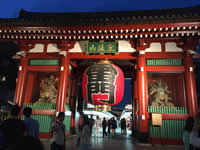
Visiting Asakusa with KIP students
Language classes are intense, but we have already learned so much. My senseis are patient and kind, but empower us to practice whenever possible. The in-class partner activities and verbal practice are enormously helpful. I also reinforce what I’ve learned by practicing the phrases I’ve learned with my friends and store clerks on the same day that I’ve learned them. On Thursday, we had to deliver a short introductory speech, and I was able to memorize mine and deliver it without the script in front of me for guidance. Although I’m sure I made an error or two, it was a really empowering moment for me as someone who was previously very shy and self-conscious in language practice. In just four days, the NanoJapan students who had started from square one learned enough Japanese to successfully communicate about our hobbies, activities and home universities. It was amazing to watch!
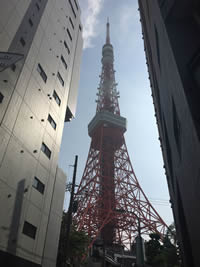
TokyoTower on the way to language classes
Intro to Nanoscience Seminar
I found the nanoscience lectures to be both fascinating and extremely helpful in expanding my understanding of the techniques I will be using this summer. Because I had completed extensive pre-reading assigned by Arikawa-sensei, Dr. Ishioka’s lecture on ultrafast spectroscopy in materials science was relatively easy to understand. Her perspective on working at NIMS as one of very few female scientists was also relatable and engaging. Dr. Stanton’s second lecture on spectroscopy for probing semiconductor nanostructures was probably the most challenging because it dove into more advanced concepts of charge carrier dynamics, transport and phonons. Although I have taken a course in solid state physics, that was nearly a year ago and I need to brush up on quantum mechanics. Fortunately, I thought ahead and brought the study guides I made during my past course with me to Japan, and I have been using them to refresh my memory. Saito-sensei’s lecture on single-walled carbon nanotubes rounded out an introduction to nanoscience that very conveniently touched on all known aspects of my project at this point. I will continue to expand my knowledge base with the readings on carbon nanotubes supplied to me by Kono-sensei.
Question of the Week
I have one burning question about Japan at the end of this week. How does this country keep itself so pristine?! There are no public trashcans anywhere, and I haven’t seen a speck of litter on the ground. I think the subway station in Azabu-juban is probably cleaner than my bedroom at home. I’ve gone several days toting around trash in my backpack until I found a trashcan hours after the fact, usually tucked away in a restroom.
NanoJapan Tip: Here is a good blog post on garbage disposal in Japan but also keep in mind this a security precaution. Public trash bins were removed from Tokyo, especially in subway stations, following a 1995 sarin gas attack by a religious cult.
This week was full of a lot of new beginnings, and I think all of us are pretty exhausted. However, I’m optimistic about my project and all of the amazing cultural adventures I have yet to have. There’s the old adage that when faced with a challenge we have the opportunity to sink or swim, and after our first week in Japan, I’m confident that I can stay afloat.
Last weekend, the NanoJapaners visited Nagano Prefecture in the heart of Japan, several hours outside of Tokyo. I’m not much of a city person, so I was eager to catch some fresh air in the countryside and meet Japanese locals beyond Tokyo’s limits. I postulated that the people I would meet during our weekend trip would be very different from the people I had encountered in Tokyo, and I found that I was right. In both my own country and abroad I have found that world-class cities like Tokyo, while diverting and full of energy, are so massive and international that they do not offer a view of the average person or lifestyle of the nation they occupy. A few examples I can think of include New York City and Barcelona. They also often have an insular, “bubble” nature that does not offer a clear view of the struggles affecting the average citizen. Maybe I wasn’t looking closely enough in Tokyo, but I did not observe the effects of population decline and economic hardship until I had the chance to speak with local villagers from Aoki-mura and students from Shinshu University in Nagano – people that were dressed a little more like me, instead of in sky-high heels and business suits. I also loved the opportunity to explore the beautiful natural side of Japan, and this weekend also made me excited to travel to Kansai for my internship where both mountains and shrines are easier to come by.
Getting to the station in such a large group was pretty chaotic and stressful, but seeing the mountains creep closer from the Shinkansen was really exciting. We arrived at Ueda Station and met our guides for the weekend from the local government of Aoki-mura and the bus driver from our ryokan. After quickly dropping our bags, we piled into the bus and went sightseeing in the area surrounding Aoki-mura. Our first stop was a shrine on the mountainside populated by small Buddhist figurines scattered along the wooded paths nearby. Both our guides and Packard-sensei explained that they were special because they were carved by the common folk to protect them, rather than by distinguished artisans. This touched me in a profound way, and I think if Packard-sensei hadn’t been walking with me keeping an eye on me I wouldn’t have left. It was amazing to see the interplay of Buddhist and Shinto spirituality and how it shaped (and continues to shape) the lives of the Japanese to this day. I think this is one of my favorite aspects of Japan – the connection between tradition and modernity. I can’t wait to explore it further this summer.
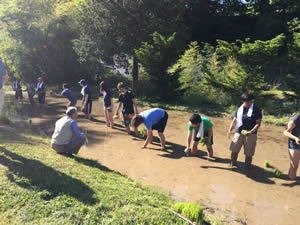
Planting rice in Aoki-mura
Our next stop was a local farm in Aoki-mura, where we had tea with several of the local villagers. They were very warm and friendly, and I can tell it meant a lot to them to share their livelihood with us. We stripped off our shoes and socks and got the opportunity to work the rice paddy behind the house of the older couple that ran the farm. We had so much fun, and since planting rice has been integral to the Japanese way of life in the countryside for centuries (eons?) I felt honored to take part in this tradition. We also enjoyed the sunny day, fed the animals on the farm, and chatted with the KIP students traveling with us. It was one of the happiest afternoons of my life. I also began to observe some newer aspects of Japanese cultural values manifested in our interactions. Hospitality was among these – despite the language barrier, everyone was so accommodating, and presented us with adorable little Totoro gifts when it was time to say goodbye. Even though some of the ladies were older they walked to the edge of the property to wave to us until we had disappeared out of sight. Friday’s adventures also included our first trip to the onsen in our ryokan (a surprisingly non-awkward bonding experience), an absolutely incredible dinner with traditional Japanese cuisine I couldn’t even really identify in some instances, and an energetic experience at Gimin Durm (a taiko studio) where we watched a performance before our young senseis taught us a routine of our own. It was a truly humbling experience trying to leap around at their speed and completely failing!
Saturday and Sunday were equally packed with activities. The next day, we picked up the rest of the KIP students and traveled to Shinshu University to have a discussion about the role of smart phones in the classroom. Although I am always worried about talking too much since the American students tend to be much more vocal in these forums, I enjoyed being in the role of a note-taker. The Shinshu/KIP students had some perspectives on the issue that I really didn’t expect. I learned that many Japanese students would skip classes or use their smartphones recreationally during lecture. I was also surprised that nearly all of the students, Japanese and American, were against prohibiting smart phones in college classrooms, though we did work together to come up with a set of ground rules for responsible cell phone usage. This exchange prompted me to think about the contemporary similarities between our two cultures, and wonder how the older generation in Japan feels about this trend. Some of the more senior university faculty in attendance seemed a little dismayed at the conclusion.
The subsequent discussion with local farmers from Aoki-mura was not at all what anyone expected. Since arriving in Aoki-mura, we noticed that local news outlets and reporters were following us around to our various activities and taking pictures, which was a little bit strange. I was a little disappointed with the discussion because the number of reporters and other locals that showed up just to stare at us made it difficult to actually communicate with the speakers. I would have loved to talk with them longer and in a quieter environment where it would be easier to translate and formulate responses to their insights about the high median age in Aoki-mura and the agricultural challenges they mentioned. Having a lot of unexpected guests definitely put a strain on the evening’s logistics, and we had an interesting conversation about it later in private. Packard-sensei reflected on the fact that even though the group essentially invited themselves to the bonfire later, we were obligated to be hospitable and polite as the “hosts” because hospitality and collectivism are so important in traditional Japanese society, even if that meant covering the additional cost. As an American, that seemed nonsensical, but I feel that I gained an important insight that may help me in sticky situations later this summer. The bonfire itself was excellent, and it was great to mingle with all of the people we’d met this weekend!
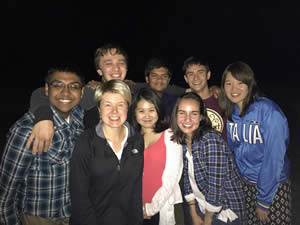
NanoJapan and KIP students at the bonfire
Sunday was our last day, and the walking tour of Aoki-mura before departing was absolutely breathtaking. However, my favorite experience of the trip was definitely our visit to Ueda High School. Although the school is special because it has a flagship English education system (reflective of Japan’s recent efforts to internationalize its education system) it was obvious that American students are not frequent guests. Our hosts were about two-dozen students and the principal, both of whom had prepared presentations, activities and a walking tour of Ueda Castle for us. Rocco and I really bonded with the three girls showing us around who were around fifteen or sixteen years old. I talked to them about their hobbies, interests, and families and after a short time we were talking and laughing. Boarding the bus back to Tokyo was very solemn as we waved goodbye to the girls, who gave us cards with their names so we would remember them. For once, all of the NanoJapaners were quiet. I think my favorite part of this experience was forming those bonds and learning about the lives of the people of Nagano, who had incredibly warm and giving hearts. I’m so grateful to everyone who hosted us, and I will miss them.
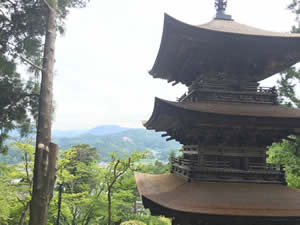
The Shrine at Aoki-mura, our last stop before leaving Nagano
Nanoscience Lectures
This week’s nanoscience lectures included “Terahertz Science and Technology of Carbon Nanomaterials” (covered in two sessions) by Kono-sensei, and “Investigating Electrons in Materials by Using ARPES” by guest lecturer Dr. Ishizaka.
During the first session of Kono-sensei’s lecture, he covered several topics that contributed to understanding the synergy between device development and semiconductor physics and exploring strategies in overcoming the physical limitations of Moore’s Law in terms of quantum phenomena. Kono-sensei began by introducing a band diagram of a traditional semiconductor and going over some of the strategies used to make nanostructures including photolithography, electron beam lithography, and molecular beam epitaxy for layered structures. He then proceeded to talking about carbon nanomaterials, a viable alternative. The main focus was low-dimensional systems of graphene (2D carbon), carbon nanotubes (1D carbon) and buckyballs (0D carbon). We went over the quantum confinement of each system and the density of states, which corresponds to the dimensionality of the carbon. Next, Kono-sensei talked about 2D materials (graphene, boron nitride, transition metal dihalcogenides) and their prevalence in layered heterostructures and band gap engineering, as well as the functional properties of 1D carbon nanotubes and the concept of quantum confinement. On day 1, we wrapped up with the two types of electron dynamics: the transport regime and the optical regime, which I recalled from previous coursework. However, Kono-sensei went far beyond my surface-level knowledge and I found the subsequent explanation of how this plays into intraband and interband dynamics in conventional semiconductors (i.e. graphene) to be very helpful. Kono-sensei’s lecture helped synthesize some of the material I already knew with current challenges in semiconductors.
During the second session, we jumped right in by going over the dependence of DC conductivity on charge carrier density in mobility and discussing the techniques that could be used to measure these properties. Fortunately, I had already encountered them in my coursework and previous readings: the Hall voltage measurement, resistance vs. temperature experiments, and spectroscopy (absorbance vs. wavelength). However, as I stated, Kono-sensei’s lectures were incredibly helpful in bringing all of these together to help me build a cohesive picture of nanotechnology piece by piece and establishing a connection to the more advanced concepts that followed. I learned a lot about the aspects of graphene and CNT that make them so unique, including their unique band structure, strong Coloumb interactions and ultrahigh carrier mobilities. We explored the relativistic nature of massless electrons in graphene along with intra/interband absorption more in depth, doping and population inversion in graphene and other methods of stimulated emission. Overall, I learned so much about semiconductor physics and design challenges that I know will really help me later during my project. Thank you, Kono-sensei!
Unfortunately, I had some trouble following Dr. Ishizaka’s lecture. She was very knowledgeable, but a soft speaker, and a lot of her research was beyond my understanding. However, I’m still so grateful that she took time out of her busy schedule to share her work with us. Photoemission spectroscopy (ARPES) was a new technique to me, and I enjoyed learning about how the photoelectric effect can be used to gather so much information about the energy, momentum, spin and orbitals of electrons in solids. I would be interested to learn more about some of the more advanced concepts she spoke about, such as topological materials and the laser high-harmonic generation by spin-splitting.
Preparation for Research Internship - Article Review
The reading assignment I will be summarizing is paper both published and assigned to me by my U.S. co-advisor, Kono-sensei, entitled “Optoelectronic Properties of Single-Wall Carbon Nanotubes” (Kono et. al, 2012).
Kono-sensei’s publication is a review of the advances in studies of optical properties of SWCNTs. This is significant because further optical studies bring SWCNT technology closer to implementing both electronic and photonic functions in optoelectronics. A lot of progress has emerged in the field of spectroscopy, which enables observation of the fundamental properties of single nanotubes. These properties depend on the chiral angle of the nanotubes, designated by (n,m) integers that refer to the chiral vector ![]() . Species in which n=m are known as “armchair”, or metallic SWCNTs, and species in which n≠m are narrow-gap semiconductors. Kono-sensei’s publication reviews several methods including resonant Raman scattering spectroscopy (RRS) for (n,m) determination, photoluminescence excitation spectroscopy (PLE) for emission/excitation phonon energies in semiconducting SWCNTs, coherent phonon spectroscopy for determining (n,m) and phonon frequency for both species, and optoelectronic applications of SWCNT films.
. Species in which n=m are known as “armchair”, or metallic SWCNTs, and species in which n≠m are narrow-gap semiconductors. Kono-sensei’s publication reviews several methods including resonant Raman scattering spectroscopy (RRS) for (n,m) determination, photoluminescence excitation spectroscopy (PLE) for emission/excitation phonon energies in semiconducting SWCNTs, coherent phonon spectroscopy for determining (n,m) and phonon frequency for both species, and optoelectronic applications of SWCNT films.
One of the techniques that Kono-sensei and his group review for effective separation of SWCNTs by type, diameter and chirality is density gradient ultracentrifugation (DGU), which sorts metallic SWCNTs from semiconducting SWCNTs by the intrinsic differences in mass density due to the different chirality of the species when suspended in different surfactants. In a study by Hároz et al., the researchers were able to use this technique to prepare suspensions consisting of solely metallic SWCNTs as verified by the spectroscopy techniques mentioned previously. Subsequent study of colored armchair SWCNTs in suspension showed evidence of excitonic interband absorption, which is significant because it conveys that both armchair and semiconducting nanotubes exhibit similar optical absorption despite having very different electronic character.
Another study by Lim et al. utilized ultrafast THz photon modulations mediated by phonons to characterize SWCNTs. This means that coherent phonons were used in conjunction with the pump-probe experiments (I read about this in the THz Spectroscopy textbook provided to me by Arikawa-sensei) to gain insight about the interactions between phonons and electrons in SWCNTs. The results obtained by the researchers were dual peaks in the energy vs. intensity distribution – evidence of band gap oscillations at the experimental THz frequencies. This is exciting because it has potential for ultrafast switching and modulation of optical beams in electronics.
The next section covered studies of conductivity in the THz range and examination of photovoltaic properties of aligned SWCNT films grown by chemical vapor deposition (CVD). Conductivity measurements are useful because they give important information on quantum interactions in condensed matter, which is essential for new solid-state devices. Experimental results show evidence of performance similar to that of commercial polarizers; the 1D character of SWCNTs led to an impressive 99.9% observed degree of polarization. It was also found that SWCNTs can absorb light across the visible electromagnetic spectrum, making them promising for solar technologies. A strong photovoltage was observed when the ultralong SWCNTs were illuminated.
Ultimately, progress in optical studies of SWCNTs has been rapid and has also opened the door for quantum electronics and new knowledge of charge carrier interactions.
After spending three diverting weeks in Tokyo and visiting many of its major districts, I have spent a lot of time on the Tokyo Metro Line, JR trains and Shinkansen. Japan’s public transportation systems are very different from the US public transportation systems that I frequent back home. Some of the examples I’m drawing on are Amtrak, the Washington DC Metro System and the New York City Subway System.
There are noticeable “rules” that citizens of the Tokyo metro area follow that deviate from American behavior. For example, people board the train differently. Although there is priority seating on trains for handicapped or elderly individuals, seats are filled on a first-come, first-serve basis. While in America it is customary to see people getting up, changing seats or offering their seat to older citizens, Japanese tend to take their seats and stay there. Although I don’t doubt that someone in obvious need of a seat would be offered one on off-hours in accordance with Japanese courtesy, during peak travel times and rush hours the cars are far too packed to allow any rearrangement. White-gloved attendants stand on the platform during these times and actually pack people in to fill the car to its maximum capacity. Efficiency, harmony, and order – these hallmarks of Japanese culture are ubiquitous if you look closely enough.
Another unspoken rule is silence. In the US, it is not uncommon to see dynamic conversations, random interactions, outbursts, or even performances on subway trains. People will lean across seats to talk to their friends, exchange witty banter in loud voices, etc. However, in Japan, travelers face straight ahead whether sitting or standing and stare fixedly at their source of entertainment or the stations whipping by in the window. Even companions and school children talk only in low voices, as if sharing secrets. Children are quieted immediately and I have been told that it would be bizarre or offensive to strike up conversation with a stranger sitting next to you, particularly as a foreigner. This seems to be the case at all hours of the day.
On Japanese public transportation, typical activities are fairly similar to the US. Nearly everyone has a smart phone that they are emailing with or playing games on. Books and portable game systems are also popular. People tend to keep to themselves, and there are definitely rules for politeness or appropriateness, which may explain why a certain group of 14 boisterous |Americans drew some disapproving looks from time to time over the past three weeks. It is uncommon to see people loitering in the middle of the standing area – people tend to line up against the walls or go as far into the car as possible to make room for people behind them. Blocking the door is also a huge no-no, and this can be a hard one since it’s fairly impossible to know which one will open. Everyone has a destination, and I have definitely been shoved out of the way when I became too absorbed in a conversation to move.
As for whether these observations arose from cultural or practical phenomena, it’s often hard to distinguish. However, I do believe that Japanese public transportation is the best example of efficiency I’ve seen in country so far. A few clueless individuals can’t really throw a wrench in a metro system that remains on time after a >7.0 magnitude earthquake, but it’s important to pay attention and be respectful. Pertaining to the Japanese values that Dr. Matherly discussed pre-departure, kata (form) and wa (harmony) are represented here.
My question of the week is about the history of the Tokyo Metro System. I’d be curious to know when it was first introduced. As such a sophisticated paradigm, I was wondering if it was among the first modern transportation systems or if it was modeled after another system. I’ll definitely be looking into this!
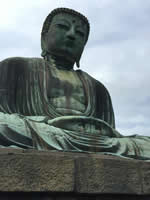
Kamakura Daibutsu, which is 43 feet tall! It took over an hour on public transportation and four train changes to take this picture. (Fun fact: I accidentally told my new co-workers today that the Daibutsu was “oishi-katta desu” instead of “omoshiro-katta desu”. So, they laughed for ten minutes straight and now everyone thinks I tried to eat Buddha. Yay first impressions!!)
Intro to Nanoscience Lectures
This week, Bird-sensei gave two lectures: “Semiconductor Band Gap Engineering” and “Graphene and its Impacts on Nanoelectronics”. We were also fortunate to have Aoki-sensei visit from Chiba University and give a talk on “Scanning Probe Microscopy and Analysis of Transport in Nanostructures Using Scanning Gate Microscopy”. I found Bird-sensei’s lectures to be particularly helpful, and I agree with his remark that his lectures would probably have been well suited for the first week of orientation.
Bird-sensei’s lecture series opened with a brief refresher on Solid State Physics. In materials, unique energy spectra are comprised of allowed and forbidden values unique to the material (as dictated by the Schrödinger equation). In a crystal, these discrete bands broaden into wider energy bands with gaps separating them. Each has a particular momentum and energy with each atom contributing at least one state to each band. Metals have a partially filled band and the electrons in the band are easily accelerated by an electric field to precipitate current flow. Conversely, insulators have bands that are either completely full or completely empty with a large band gap. Semiconductors fall somewhere in between, with bands that are completely full or empty at low temperatures, but have a small band gap such that an increase in temperature can increase conductivity. Thus, electrons can be excited into the conduction band, leaving positive charge carriers (“holes”) behind in the valence band. Holes also have an inverted energy scale from electrons.
In his discussion of how the band structure of materials is affected by an electric field, Bird-sensei went over the PN junction and its resulting depletion layer, the simplest configuration of an interface. However, as he mentioned, most devices will have much more complicated configurations. I was intrigued to learn about the different alignments (Type 1, Type 2, and Type 3) in multilayered heterostructures such as GaAs/AlAs (Type 1). In this structure, the growth of a thin layer of GaAs between the two AlAs layers gives rise to quantum wells that charge carriers can occupy. In his second lecture, Bird-sensei went over the electrical properties of graphene that make it so remarkable [I will mention these in detail in the subsequent section of this report in response to his questions]. He did an excellent job explaining some of the design challenges associated with making graphene devices, and I feel as though I have a much better understanding of the link between semiconductor physics and device fabrication.
Finally, Aoki-sensei’s lecture was very informative because I knew very little about optical microscopy beforehand. Scanning Probe Microscopy (SPM), Scanning Tunneling Microscopy (STM), Magnetic Force Microscopy (MFM), and Electrostatic Force Microscopy (EFM) were discussed along with their different components, modes of operation, and the theoretical basis of operation. It was very interesting, but very advanced – some topics I had never heard of before, like the Kondo Effect, which shifts the focus point of the density of states in STM, giving the appearance of a phantom atom.
Sitting at my desk writing this report on a Friday evening, it feels as though the first day of my internship was a full decade ago. While I don’t feel ten years older and wiser, I have been immersed in reading papers, gathering data, analyzing data, and other miscellaneous forms of studying. I really enjoy my time spent in the lab, and I feel orders of magnitude more grounded than I did on Monday evening. I’ve met so many people this week (and I’m ashamed that I don’t remember all of their names) and their kindness and patience has helped me start to adjust to the new normal. I think what helps most is how excited I am about my project and all of the physics I am learning, making new friends, and having the beautiful city of Kyoto right at my doorstep (even if I haven’t had a free moment to explore it yet).
My first day was a blur. Arikawa-sensei picked me up at my apartment to show me the way to campus. I really took the program’s advice to heart and dressed up by wearing business slacks, heels, and a blouse – not my typical attire. I was already feeling a little uncomfortable in my own skin, but seeing people stare at me as I walked by was a little unnerving. Kyoto is not the sprawling, international metropolis that Tokyo is; foreigners are far more scarce, and although I’ve encountered one or two visiting professors speaking French and German in the hallways of Kyōdai, that was definitely something I had to get used to. But I digress. When we arrived at the lab, it was just before the start of the weekly lab meeting. While we waited, Arikawa-sensei showed me some of the equipment I will be using this summer. I was then introduced to the entire lab group at the meeting, which was very brief and mainly consisted of my awkward introduction in Japanese. Even though I’m sure I spoke poorly, everyone applauded when I finished, which was very kind. I also presented gifts to the lab secretary, Nakamura-san, along with my senseis: Tanaka-sensei is the Professor, Naka-sensei is the Associate Professor, and Arikawa-sensei is the Assistant Professor in our lab. I felt as though I did this rather clumsily, but I hope they liked the UMD omiyage I brought with me. Afterwards, I joined in on the group cleanup of the office before walking to lunch with my lab-mates. Arikawa-sensei had a meeting in the afternoon so I basically just learned how to use the Wi-Fi/printer, waited for my luggage to be delivered, and dragged myself home around 4 PM.
The next day, my training commenced. My mentor and supervisor is Arikawa-sensei, who is very approachable and knowledgeable. Although he is my primary advisor, I can also ask any of the graduate students for help when I don’t know how to do something. I spend a lot of time working on my own after Arikawa-sensei demonstrated how to use each setup because the measurements I took this week were pretty straightforward – basically, the biggest challenge was mounting the sample, and then I would just have to adjust the polarizer angle, adjust the settings, and hit a button twenty times or so before performing the necessary conversions and plotting the data on my computer. Arikawa-sensei was always available whenever I had questions, and would review the results with me once I finished so that I could establish a better understanding of the phenomena I observed.
All of the professors in the lab speak English with a high degree of fluency, so I usually converse with them in English. I found that although some of the graduate students were shy to speak English with me at first, but me using Japanese (however poorly) was a good icebreaker. About 2/3 of the students speak very good English and can understand me well (although they are still convinced that their English is poor…what???). I will definitely be able to work effectively in my host lab.
For the first few days, I was seriously worried that I wasn’t going to make any friends. Besides the daily group lunch, no one really talked to me very much, and I found myself sitting alone in silence for most of the day at my desk. After feeling sorry for myself for 48 hours or so, I realized that I could to a lot more to change this instead of just waiting for people to come to me. One major criticism that I have of myself since arriving in Japan is how timid and inhibited I’ve become in social interactions; in the United States, I am very comfortable, sociable and outspoken in both casual and professional settings. In Japan, I have often found that I am so anxious about being incorrect, annoying or loud that I simply just don’t say much at all (in Japanese or English). It’s frustrating, and I’ve made a conscious effort to change it. I found that once I reached out to my lab mates by sending them messages, leaving them gifts and expressing my appreciation, they quickly opened up to me. Tomo-san and Hikaru-san were especially welcoming, and Hikaru-san even invited me over to her home for dinner tonight. Next week, I am going on a variety of outings with several different members of my lab, and I have learned an important lesson this week – one truly gets out of a relationship what they put into it, especially in Japan. I feel fortunate to spend time with people who are so eager to share their culture, work, and personal time with me.
My housing situation is excellent. My apartment is just 8 minutes away from the lab on foot, so I don’t have a long commute at all. It’s very cozy, and having my own kitchenette and bathroom is a luxury. I’m getting the hang of grocery shopping, cooking and cleaning on my own, and it’s definitely WAY nicer than my dormitory housing back home at UMD. Living alone has also been a great experience so far because I really enjoy having my own space in which to recharge at the end of the day.
After Arikawa-sensei, Kono-sensei and I talked about the goals of the project in greater detail earlier this week, I feel I have a solid understanding of what we are trying to accomplish this summer. I have begun working on the project, and actually made considerable progress with Arikawa-sensei towards completing “Phase One” of characterizing the material I will be working with and duplicating the results from Kono-sensei’s group. I am a little worried about time because according to our timeline I will not be beginning the main experiment until after Arikawa-sensei and I return from Okinawa, but as of now I think we will get everything done.
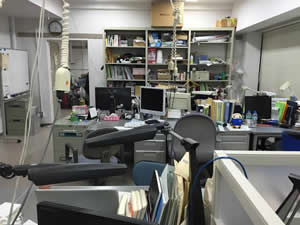
The view from my desk in the Tanaka/Arikawa Lab! It was pretty deserted early on Friday because many of the graduate students have class at that time.
Assessment of Orientation Program and Language Classes
Overall, I thought the Orientation Program was a very thorough and enjoyable introduction to life and research in Japan. I am still amazed at how much I learned over the course of just three weeks, and I am fortunate to have made some wonderful, lasting friendships. I think the portions of the program that were most helpful and interesting were the cultural activities that we did in conjunction with local students, especially the KIP students. Not only were they able to provide valuable insights of current issues in Japan, they also introduced us to life in Japan through the eyes of a young person. I feel so grateful for the amount of time they spent in our company, and I already miss them very much. The nanoscience lectures were also integral to establishing a solid understanding of our projects; however, I felt that one or two of our guest lecturers’ talks were too far beyond my knowledge base to be very helpful.
One major regret I have about my Japanese language learning experience to date: I should have done my homework in kana. I think writing in romaji (although, in the beginner classes, we all did it) severely hindered my progress with reading kana on the fly. That said, considering I started from square one with this language, I am proud of the progress I made during orientation. The six-student beginner classes were enormously helpful, and I had the most wonderful senseis. My future language goals for the summer are to practice what I learned with the JBP textbook every day for at least an hour, memorize the “survival” Japanese vocabulary, begin using more complex sentence structures in daily speech and reach a level of comfort with the language where I can travel between cities on my own without having to resort to charades.
It’s very difficult to choose one single, most important thing I know now that I didn’t know when I arrived in Japan a month ago (yes, we’ve been here for a MONTH!). In general, the vast stores of knowledge on Japanese etiquette we were exposed to were very helpful, and it has really made a difference in my lab experience. Tomo-san told me that Arikawa-sensei commented that all of the NanoJapan interns have been so polite in recent years, which was very nice to hear.
Finally, three burning questions I still have about Japan after the orientation program: 1. Other than dialect, what are some of the major differences between life in Kansai and Kanto? 2. How far is the Japanese government willing to go to “internationalize” the Japanese way of life in order to combat the population decline? 3. Is Packard-sensei superhuman? Because she is one of the most powerful women I’ve ever met. :)
NanoJapan Research Project Update
Research Project Overview: The working title of my project is “Nonlinear Optical Responses in Aligned Single-Walled Carbon Nanotubes”, and spectroscopy is the primary means of investigation. As part of my introductory project, I am reproducing results from previous work with aligned SWNT by Kono-sensei’s group pertaining to the material’s high anisotropy and alignment. Essentially, I am verifying the linear responses by taking MIR and THz polarization-dependent transmission measurements. The absorbance should be close to zero when the electromagnetic radiation is perpendicular to the SWNT alignment axis, and should be very high parallel to the axis. This will result in a degree of polarization close to 1. For the main experiment, I will be investigating higher-order nonlinear optical processes in SWNT such as nonlinear absorption saturation, frequency mixing, harmonics generation, etc. These phenomena should be akin to those observed in graphene, which has strong intraband nonlinearity. We will also investigate chirality-enriched samples, looking closely for the expected strong nonlinear behavior unique to metallic SWNT. These findings would have exciting implications for novel THz optoelectronics.
Research Methods: For what I’ve started referring to as “Phase One” of my project, I have used/will use several different pieces of equipment to obtain an absorption spectrum of the aligned CNT film. The focus material is this sample, which is not enriched with a certain chirality (neither entirely metallic or semiconducting) and is analyzed on an intrinsic silicon (iSi) substrate alongside an iSi reference. Kono-sensei will provide additional samples from his group that may be chirality-enriched for further study.
Training: To save time, I am using a program called Origin for data analysis and plotting that I have access to as a UMD student and am already familiar with from my coursework last semester. Most of the lab uses IGOR, so I am largely responsible for learning how to perform new functions in Origin myself. Besides learning how to operate equipment, I also have a lot of theory to learn about the nonlinearity in graphene (closely related to CNT), so I have been reading several papers by Mikhailov et al. provided courtesy of Kono-sensei.
Timeline: This past week, the week of June 8th, I performed MIR spectroscopy on the sample to investigate the angular dependence of the spectra and was able to replicate the anisotropy that Kono-sensei’s group has found. This week, the week of June 15th, I will learn how to use the THz setup and will characterize the sample in the THz range using the low-power Ti-Sapphire laser and EO sampling method. Arikawa-sensei estimates that this experiment and the subsequent analysis will span two weeks, so I will likely be working on this during the week of June 22nd as well. The week of June 29th is the week leading up to the mid-program meeting and MTSA Conference in Okinawa; we don’t have much planned for this week since my mentor is departing on June 30 to travel to the conference and I will be departing the following day. After returning from Okinawa, the week of July 6th will mark the beginning of the critical experiment, investigation of the nonlinear THz response of the aligned SWCNT film using the larger laser and wave-plasma sampling. This is estimated to take two weeks. The week of July 20th will be reserved for final data analysis and poster preparations, and I will finalize my poster during the last week of the internship (the week of July 27th) in anticipation of the July 31 deadline.
Questions or Issues: One delay that I noted above is that the laser I need to use to perform THz spectroscopy on our current sample is undergoing repairs, and may not be available until Wednesday or Friday. As for questions, Arikawa-sensei and I were also wondering about the thickness of the CNT film I am currently characterizing.
As I have noted before, the extensive anecdotal cultural training we received prior to arrival in Japan was incredibly helpful but also had the effect of causing some paranoia on my end (which is nobody’s fault but my own). The incident I will be analyzing happened in Tokyo, during the first week of language classes (in which we had rotating senseis). After class had finished one day, I lingered after my classmates had left to send a message on my smart phone. It was late in the evening in the United States, and my mother had sent me a message during class to tell me about my younger sister’s final performance that had happened earlier that evening. Alena had stayed behind to wait for me, but all of the other students had already left.
Ogata-sensei approached me after I sent the message and put down my phone. She smiled and asked me in a mild tone, “Julia-san, did you receive a message from home?” I’m not exactly sure why, but I had a flashback to the incident we discussed during orientation where a student was indirectly chastised by their Japanese mentor without realizing it. I stared at her for a moment and blushed, thinking I was being gently reprimanded because had done something disrespectful by texting in front of her even though class was over, and replied “Yes, from my mother.” She said “It must be very difficult to stay in touch with the time difference. Do you Skype with your family?” I think I stammered some kind of affirmative, and then we said goodbye and left. I asked Alena in the elevator whether she thought I had done something to offend and if I should apologize. “I’m not really sure…maybe?” she replied. Still worried, I asked Aaron about it when we caught up to the group, since he has a lot of experience interacting with native Japanese. “I really don’t think she was upset,” he said. “I think she was just being friendly and trying to talk to you.” Thinking he was probably right and feeling a little embarrassed, I never brought it up again to Ogata-sensei, and neither did she. However, as I got to know her further over the next few weeks, it became obvious that she was a very sweet and sociable person and she quickly became my favorite sensei.
In retrospect, it seems obvious that she was trying to be friendly and ask about my life to get to know me and make me feel welcome, and I responded by behaving awkwardly because I was still struggling with a fear of offending in a society that doesn’t give explicit cues. I didn’t realize there might have been a misunderstanding until I consulted my classmates, but now that I’ve been in Japan for several weeks I think I am more attuned to Japanese social cues. Minor instances like this one have occurred since, and when I am unsure if something I am doing something wrong I simply ask or apologize to be on the safe side. The Japanese may not be as direct as Americans, but at least this demonstrates (I hope) that I care about the effects that my actions may have and gives them a chance to correct me. My question of the week is if any of the NanoJapan staff members can comment on this with their own insights, and if there is anything else I can do in the moment if I am unsure that I have done something wrong.
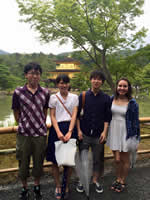
Thursday was a holiday for Kyōdai students, so my lab mates took me to see Kinkaku-ji Temple (shown here) and Nishiki Market!
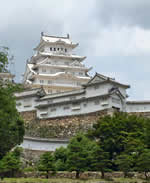
Himeji Castle, newly restored and open to the public again, as pictured during the Kansai Krew’s trip to Himeji on Saturday.
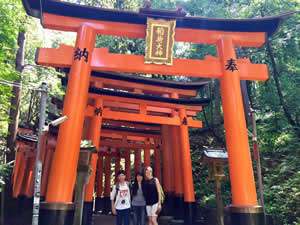
Alena, Rebecca, and our friend Tomoki (one of the KIP students) came to visit Kyoto on Sunday and we went sightseeing. Fushimi Inari Shrine was breathtaking!
NanoJapan Research Project Update
This week wasn’t quite as progressive as the previous week because of some frustrating setbacks in the lab. Early in the week I performed some calculations on the polarization-dependent transmission measurements I had obtained the week prior to obtain experimental values for the linear dichroism and degree of polarization of the sample, which were supposed to reflect the anisotropy and extremely high alignment in the SWNT sample. However, even keeping in mind that our sample was not identical to the one studied by Kono-sensei’s group, the results were kind of puzzling. The reduced linear dichroism trended below zero, and the degree of polarization did not approach ~1. After talking about this, Arikawa-sensei recommended that I perform the measurements again obtaining measurements of the reference iSi substrate (even though it is isotropic) to account for experimental variability; that is, the basal intensity environment in the setup will likely change over several hours of data collection. He also found the spec sheet for the polarizer I had been using, and we learned that half of my measurements were taken beyond its range of 4000 cm^-1, so we decided that I would only use the data collected within range to obtain values for the linear dichroism, etc.
Unfortunately, I misunderstood and took isolated measurements of the substrate at each angle I had scanned the sample previously. Arikawa-sensei explained that this would not be helpful because the point was to minimize the time difference between the sample and reference measurement – the intensity was that susceptible to fluctuation. Basically, I had wasted an afternoon, and I was really frustrated with myself for not figuring that out on my own. Thursday was a university holiday and no one worked in the lab, so I resumed Friday, this time properly scanning the reference followed by the sample at each angle over the course of the afternoon. It was difficult to optimize the signal at times because the intensity would occasionally drop off (I really understand now what Arikawa-sensei meant) but I did my best to be consistent and group the data accordingly. After calculating the transmission based on the reference measurement at each angle and performing the calculations again, the anisotropy is more clearly pronounced and the values for LD’ and DP are at least trending towards the values I expected despite some distortion at the edges of the frequency range (see figures below).
The Tsunami laser that is used for THz characterization is still down, so I can’t move forward with my project in that aspect. I am a little anxious about the effect this will have on the timeline of the project, but research is not always a linear process (pardon the pun). However, Kono-sensei’s group has provided three new samples for me to analyze that are chirality-enriched: a (6,5) semiconducting SWNT film, a (6,6) armchair SWNT film and a third slightly arc-aligned semiconducting sample. This week, I will repeat the MIR characterization I have done with the non-enriched sample using these samples.
I’m still trying to digest some of the theory behind the nonlinear phenomena I will be investigating in the main experiment. The mathematics are rather advanced for me, so progress is slow. However, as a non-Physics student I’m having a lot of fun getting out of my comfort zone with this project and learning more about optics and optical properties of materials, which has been my favorite aspect of my field of study so far. I’m confident that if I keep chipping away at it, I’ll get there, and I feel as though my current level of understanding is definitely sufficient enough to briefly explain my project at the MTSA conference. I will have my presentation completed by the end of the week for Kono-sensei and Arikawa-sensei to approve.
Outside of research, I think my biggest personal accomplishment would be becoming more independent and confident in general. I was a little bit nervous for this experience not only because I wanted to be successful in my research but also because I also knew I would be exposed to a wide breadth of new experiences that would challenge my ability to adapt and respond under pressure. Some of these include living and traveling alone, making new friends in an unfamiliar place, and overcoming communication barriers.
Before this experience, I was often embarrassed to ask for help and irrationally afraid of making mistakes. This carried over into my first week or two in Japan as well – I found my confidence hitting a low. I was also very hard on myself for things that just weren’t a big deal in the grand scheme of things. Now that I have made a TON of mistakes living alone, traveling, and taking more risks (the good kind!) I’ve learned that mistakes are an essential part of the journey out of one’s comfort zone and learning through experience. I find that adopting the perspective I had during my first marathon helps; with every step I’m going far beyond anything I’ve experienced before, which is worth celebrating.
I think my biggest personal challenge has been finding a set weekday routine that works for me. Historically, I prefer structure and order in my daily schedule to keep me grounded and focused, and I was totally not prepared for the amount of personal freedom I would have living alone in Kyōto! It’s rare that I have to arrive or leave the lab at a set time, for example – it’s up to me to show up early enough to accomplish everything I need to in a given day, and leave when I think I’ve finished everything I needed to. When I come home at night, I usually just talk to family, relax and go with the flow in terms of when and how long I pursue other tasks (practicing Japanese, exercising, etc.). It’s not that I’m not making any progress in these areas, but I think I could definitely accomplish more each day after my work in the lab by setting some guidelines. For example, starting this week I will study Japanese from 9:00 pm to 10:00 pm. Maintaining a set schedule was much easier to do when I lived in a dormitory environment with a lot of other hardworking students, but now that I’m living alone it’s up to me to make sure I create that environment for myself to maximize my progress (especially with Japanese language learning!). I’ll report back with how this added structure helps.
Everything is pretty swell here in Kyōto, so fortunately I can’t think of any issues that I’d like to bring up. Research is chugging right along; we received the Kono Group’s additional samples on Tuesday and I was able to characterize them and plot the data by Kono-sensei and Sarah’s visit to our lab on Friday. Arikawa-sensei, Kono-sensei and I went over the results of my FTIR experiments, paying special attention to the most recent samples of SWCNTs that are chirality-enriched. We were all pleased to see that the samples’ linear responses aligned with Kono-sensei’s expectations given their type and alignment (or lack thereof), and we are excited for the next step of characterizing the linear response using THz spectroscopy. Unfortunately, the Tsunami laser I need to do this is still not fixed, but Arikawa-sensei informed us that it would be operational by the time he and I return from Okinawa. Although we are technically behind our initial schedule, neither Kono-sensei nor Arikawa-sensei had any qualms about me finishing both the linear characterization and the main nonlinear experiment on time. I am confident that I will be able to complete everything, including my poster, by the end of July.
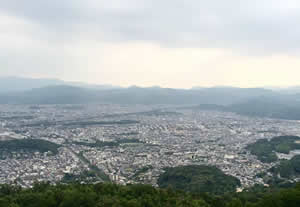
The view of Kyoto from Mount Daimonji
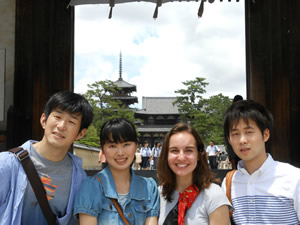
My friends from the lab showed me around Nara this weekend! Here we are at the gate of Hōryū-ji, one of Japan’s oldest temples and its first UNESCO World Heritage Site.
Research Project Update
Last week, I replicated my previous FTIR measurements with the aligned, non-enriched SWCNT sample on the three new samples we received courtesy of the Kono Group: I. Unaligned semiconductor (6,5) SWCNTs, II. Unaligned metallic (6,6) SWCNTs and III. Arc-aligned semiconducting SWCNTs. The subsequent analysis of the data gave valuable insights and confirmed the expected linear response in the SWCNT samples.
At the end of orientation, I would say my speaking skills in Japanese were probably at the level of a Japanese toddler, from what I’ve heard on the trains. Although I had learned a lot of vocabulary and sentence constructions over the three weeks of orientation, it was a little bit like drinking from a fire hose. This had the effect of bolstering my listening comprehension but restricting my speaking to a pretty basic level since it was difficult to retain everything. However, I had a lot of fun during class, and as someone who had not studied a foreign language since my junior year of high school I was surprised at my progress. Since coming to the lab, most of my practice has been with my lab-mates since I am the only non-Japanese in the lab, and as such my articulation has improved a lot. However, I have not made enough progress because I did not establish a set routine for practicing the language on a daily basis – it’s kind of just been when I have time, and through whichever media I feel like using (TV, textbook, PowerPoints). I know I will regret it if I do not become more productive with my studying, so I have started studying at least an hour every day using my notes from class and, very recently, the e-learning website Shimojo-sensei recommended that was so helpful in learning kana.
I think my most challenging linguistic experience happened at one of my lab-mates’ houses a few weeks ago. We were having a takoyaki-making party, and the hostess (Hikaru-san, probably my closest friend in the lab) invited over one of her friends who had just left her shift at work. She was very sweet and I enjoyed talking with her, but she didn’t speak much English. I stammered my way through a conversation, but I was ashamed because certain things that she asked me Hikaru-san had to translate when I had already learned how to answer that question, i.e., what did you do last weekend? After thinking about it, I identified two main reasons why I struggled. First, we learned the -masu form of verbs almost exclusively, with a brief introduction to the more casual dictionary –ru and –nai forms. It’s relatively easy to completely miss the meaning of a sentence because often these forms do not resemble the –masu form closely enough to catch that the same verb I’m familiar with is being used. Second, sometimes it’s difficult to practice speaking Japanese because it’s obvious that I am a foreigner, so if I hesitate after someone asks me a question (even if I was just going to ask them to repeat what they said more slowly) the speaker will quickly revert to English or someone will translate immediately. I think this is mainly out of courtesy, but sometimes it makes me a little embarrassed so that I just switch back to English. The Japanese speak very quickly but giving a blank stare is a sure-fire way to ensure that that person won’t attempt to speak Japanese with you as a default in the future, not because it’s assumed that you’re incompetent but because as a foreign visitor you are not always expected to be trying to learn or actually practice Japanese. Persistence is key, and recently I’ve been trying to force myself to speak more in Japanese, even if I get a response in English.
When I return to the United States, I would like to continue my studies of Japanese. The NanoJapan experience has taught me that I am much more successful within the structure of a class. The Japan America Society of Washington D.C. (JASW) is located very close to my university and offers relatively affordable evening classes once a week in four different semesters throughout the year. I plan to become a member of the society (undergraduate students get a membership discount! J) and continue my Japanese studies this way. Unfortunately, the Japanese courses offered by the University of Maryland cater to language majors and are 6 credits, which would be impossible with my existing course load. However, the Japanese American Student Association (JASA) offers many events on campus I can take advantage of, including language house conversations.
The Mid-Program Meeting was overall an excellent experience, and it was wonderful to have the group together again. I benefited a lot from our group discussion, and some of my main takeaways were the following:
With regards to how I plan to integrate these points into the next four weeks, I think mentally preparing to work extra-hard under pressure is important. I also need to be more proactive in seeking out my mentor when I need help understanding a concept, like what specifically to expect in the THz responses of each of the samples I am working with. Finally, I have a game plan for maximizing the time I have left in Japan to practice my languages skills that I outlined above.
Finally, getting the opportunity to explore OIST’s main campus and attend and participate in the MTSA Conference was incredibly valuable. It was my first time participating in a conference in my field of study, and I think having the experience of preparing and delivering a talk on my project helped me synthesize my understanding of my project more than I initially realized. It was also humbling to be in the presence of some of the most eminent researchers in the field and to have the chance to learn about their research. OIST has state-of-the-art facilities, and from touring Dani-sensei’s labs it’s obvious that the international, multidisciplinary educational approach that OIST pioneers creates confident, knowledgeable researchers. I think that OIST’s model is the future of graduate education, and I’m definitely considering applying!
My question of the week is about Okinawan history. The main island is essentially equidistant from Japan and China, and I noticed a strong Chinese presence on the island in terms of the people visiting but also the art and cultural influences. Was there any backlash about Japan annexing Okinawa? I will be consulting Google-sensei about this.
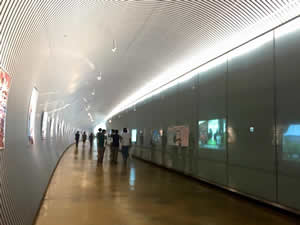
Walking into OIST’s main building felt like being on the set of Star Trek
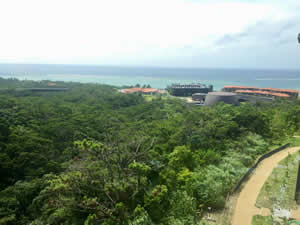
I don’t think anyone got sick of this view from OIST’s sky bridge. 5 years of fully funded graduate studies? Hmm….
Research Project Update
I have not made any additional progress to report on my research project. Last week I was only in the lab on Monday and Tuesday, and the Tsunami laser was not operational so I did not perform any experiments. I did not perform any experiments on Monday or Tuesday of this week because the laser is still offline, and I am becoming concerned about time. Upon returning to the lab on Monday, Arikawa-sensei informed me that the Tsunami laser had still not been repaired, but that a temporary replacement would be installed on Thursday. I asked him if there was any additional training in the meantime I could do to prepare for the experiment or become familiar with the nonlinear setup, but he replied that there is not. Additionally, I asked about using the AFM in the lab but it is very old and no one can teach me to use it, so I cannot measure the film thickness while I wait for Thursday to arrive. Basically, I am confined to reading papers until Thursday or potentially Friday. My goal is to reach a high level of understanding of what is going to happen, especially with regards to the THz response I am anticipating to see in the different samples per Kono-sensei’s presentation feedback. With only 3 weeks left after that to complete the remaining two thirds of my project, write an abstract and make a poster, I anticipate some long nights/weekends in the lab to make up for all of the lost time due. I’m up for the challenge!
I am working in the Solid State Spectroscopy Group this summer, in which my mentor Arikawa-sensei is the Assistant Professor, Naka-sensei is the Associate Professor, and Tanaka-sensei is the Professor (the big boss). Our lab is very comfortable but the signs of the hierarchy described to us during orientation are definitely present as well. It creates an interesting contrast, but the two dynamics complement each other very well. I love this, because over the past two months, the unexpected compatibility and peaceful coexistence of certain elements of Japanese culture has been my favorite thing to observe. Some other examples are the harmony between tradition and modernity, Buddhism and Shinto, or humanity and nature.
In terms of “rules”, the lab itself is not very formal, and there aren’t any outlandish restrictions on how people interact. Tanaka-sensei and Naka-sensei are always given the ‘-sensei’ honorific. Arikawa-sensei is sometimes given the ‘-san’ honorific by the older graduate students, and I think this is probably because they are fairly close in age. The ‘-kun’ honorific is given to younger males, and it is often more familiar and affectionate. People usually call me “Julia-san” or just “Julia”. Also, I have found that honorifics are less important when the relationship is very familiar. I finally asked my closest friend in the lab, Hikaru, if it is strange when I call her “Hikaru-san”, and she confessed that it is because she views us as being the same age and since we’re friends I can just call her by her given name.
When people disagree, how it is handled totally depends on who is involved. Even though I usually can’t understand the conversations between the professors and students since they are spoken in rapid Japanese, I can’t recall ever observing a student appear challenge or disagree with Naka-sensei or Tanaka-sensei directly. Occasionally they will come back back from the professors’ offices with new corrections to the papers they are writing saying seeming exasperated and saying something along the lines of “I can’t win”. Multiple people have explained this to me on several occasions: “Tanaka-sensei/Naka-sensei is very kind. But he/she is VERY strict about physics.” Students will complain to each other, though, and although I haven’t witnessed a major uproar people will banter playfully.
I suppose our lab’s dynamic could be summarized with an anecdote from my first week at the lab. On Wednesdays, the professors and students gather for one of several seminars called “Journal Club” (roughly translated). Basically, it is the responsibility of one of the master’s or doctoral students to prepare a presentation of a paper that is interesting or related to their research. I’ve heard about similar activities in American labs, so I came in feeling pretty confident that I knew what was going to happen. What I didn’t expect was seeing Tanaka-sensei trotting back and forth in flip flops (and occasionally bare feet) throughout the presentation and sitting back in his chair while the first-year master’s student fielded his and Naka-sensei’s questions for THREE AND A HALF HOURS. Their attention to detail was meticulous! I was so confused because on the surface the meeting seemed very relaxed, but it was clear that this responsibility was taken very seriously and even though he was a newcomer, the senseis had high standards in terms of what he could explain and understand.
In terms of values, I believe that sheer diligence and hard work is valued and respected in Japanese labs. Community and harmony are also important, as we learned in orientation; everyone in the group pulls their weight, even younger students. I do not think that these things are undervalued in the U.S., but I think people tend to work more independently on their own projects and there is less of a “team” atmosphere. I certainly don’t get meals with my American PI’s; in fact, I rarely see them, because they just don’t check in as much. There is also less of an emphasis placed on the hierarchy in U.S. laboratories. Many times I have heard my professors say that they want to be challenged or asked questions, because they enjoy the feedback and fresh ideas from their undergraduates and graduate students.
It is difficult for me to say which environment I prefer, because I enjoy aspects of both equally in very different respects. I think ultimately I’ve enjoyed my experience working in a Japanese lab more, because even with the language barrier I feel like a part of a family and I am empowered to learn more and explore my potential here. I do miss some aspects of working in a lab in my own country, but honestly not as much as I expected to. Every day I am excited to go to work, see my lab-mates and learn as much as I can.
One question I have: after talking to my fellow NanoJapaners, it seems as though our group is on the smaller side with a dozen graduate students and three professors. Is this true? We also do not have any international students (besides me), which may be part of the reason.
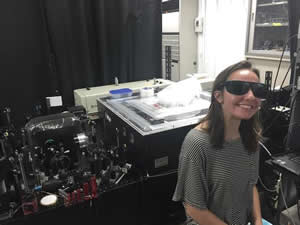
Me using the smaller THz Time Domain Spectroscopy (TDS) setup with incredibly stylish safety glasses.
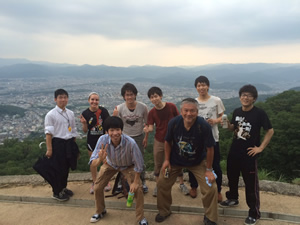
Throwback to when some of the lab members hiked to the top of Mt. Daimonji! (Photo courtesy of Arikawa-sensei)
Research Project Update
During the past week, Arikawa-sensei and I have discussed the trajectory of my project and clarified some of the main goals of our final experiments. Once I have finished characterizing the linear response of the SWCNT films, we will turn our attention to the nonlinear response where our primary objective will be to observe high harmonic (HH) generation in the metallic and mixed samples. This is partly because this is the most straightforward phenomenon to investigate in terms of the setups we have available. However, HH generation also has promising applications for powerful THz emitters and efficient frequency multiplication, so our findings would be a valuable addition to the field.
Once the Tsunami laser was replaced with a temporary substitute Arikawa-sensei had to calibrate the alignment, which took several hours of hard work on his part. I was then trained to use the system (Figure 1), and we calculated the time delay of the signal with the silicon substrate as well as the optimal length of the sampling window (roughly 5.7 ps and 14.7 ps, respectively). We decided to begin with the aligned, mixed film but were presented with a bit of a challenge, because even with the clever plastic bag setup depicted in the picture above it was necessary to alternate between mounting the plain iSi wafer and the sample to obtain reference measurements for calculating the transmission of the SWCNT film. Every time I opened the chamber meant a 30-minute period of waiting while the system was replenished with dry air; the presence of water in the atmosphere results in sharp peaks in the absorption spectrum. Arikawa-sensei suggested switching out the sample for a reference measurement four times over the course of 15 sample measurements, but I found that this imposed a large degree of variability in the true polarization angle because it was nearly impossible to re-mount the sample in exactly the same configuration after each reference measurement. As a result, there was not a clear trend in the resulting spectra between polarization angle and absorbance after I converted the waveform output to the frequency domain using the Fast Fourier Transform (FFT) algorithm in Origin. Fortunately, the results showed that there was very little change in the intensity of the reference signal over the course of the experiment, so we opted to repeat the measurements, but this time I only measured the reference once and then performed all 15 measurements in sequence, altering the polarization angle of the rotating mount without having to remove it. I also performed additional measurements to verify the maximum and minimum amplitude of the waveform, and this resulted in a nice, systematic trend in the absorbance spectra (Figure 2). Figures 3 and 4 depict the maximum and minimum absorbance spectra as well as calculations of the reduced linear dichroism and degree of polarization of the sample.
Tomorrow, I will complete similar measurements on the aligned semiconducting film along with the unaligned (6,6) and (6,5) samples. After Arikawa-sensei and I review the results together, we will transition to the nonlinear experiment by the end of the week barring any more unexpected delays.
For this assignment, I met with Associate Prof. Nobuko Naka of Kyoto University and the Solid State Spectroscopy Group. Although Naka-sensei is a member of my host laboratory, I have not gotten the chance to speak with her much during my internship and we have not worked together previously. She is a kind and sociable person, and we had a very enjoyable, engaging discussion about the history of her career and how it compares to those of US researchers. I am grateful that she agreed to free up a portion of her busy schedule to speak with me! I was surprised to learn of many similarities between the trajectories of American and Japanese researchers, but the key differences we discovered were very important as well.
Naka-sensei’s story of how she came to study physics is very interesting. In junior high school she enjoyed mathematics very much and became hooked on physics during her high school experience. She shared with me that a pivotal experience for her was an opportunity she had following her second year of high school to conduct a research project at Tokyo Institute of Technology (where Anish is currently working) under the guidance of university students studying high critical temperature superconductors. She described the process of baking and preparing the superconductor pellets with their help and how fascinating it was to learn skills that she simply didn’t have the resources to study in high school, such as soldering and using a cryostat. The moment where Naka-sensei knew she wanted to study physics came during the experiment when she was able to see the resistivity of the samples change before her very eyes.
Afterwards, she went on to study solid-state physics at the University of Tokyo after passing her entrance exams. She originally wanted to return to the Tokyo Institute of Technology where she had conducted her high school project, but her parents were adamant that she should attend a university that did not just focus on science and technology so that she could also be exposed to other disciplines such as literature, art and history. She was surprised and amused to learn that my parents had told me the same thing when I was applying to college to study engineering! She was also surprised to learn that there is still a small population of females in science and engineering in general, particularly in academia, in the United States.
I told Naka-sensei that one of the graduate students and my friend, Morimoto-san, told me that the doctoral track is not as popular in Japan as the United States because many students prefer to start a career. She affirmed this, telling me that most of the students in the lab are currently job-hunting, and surprised me by saying that she was originally in their shoes! Naka-sensei considered quitting her PhD and leaving the university to go to industry, but she was disappointed after visiting several companies because of their treatment of women. When she asked one employer if it was true that the employees work late into the night, he replied that this was true but as a woman she would not be permitted to stay past 5:00 pm because she would need to return home to fulfill her domestic duties! I was completely shocked by this. She assured me that things were getting better for Japanese women in the workforce, but that this was why she chose to finish her degree and pursue a career in academia. She had a very supportive advisor with a unique perspective who pushed her to present her work and did not limit the scope of her opportunities based on her gender.
After she obtained her PhD, Naka-sensei had an international experience in Germany through a fellowship with the Japan Society for the Promotion of Science (JSPS). Although she was there for only six months, she asserted that this position not only challenged her communication skills but also changed her perspective on physics as a field of study. In Japan, people rarely speak up in meetings, and Naka-sensei feels that because of this many ideas are lost; she enjoyed how passionate and verbose the German researchers were about their work, and has retained this in the lab environment that she, Tanaka-sensei and Arikawa-sensei have created for their graduate students. They require all doctoral students to present to the group in English, which is apparently unique to this lab, because they feel it is absolutely critical that they prepare for their careers by learning how to express their ideas to an international audience. Naka-sensei added that she thinks the Japanese language is ill suited for discussions of science anyway, which I thought was very interesting. She also thanked me for visiting this summer and for “stimulating” the graduate students!
My conversation with Naka-sensei provided me with these critical insights about the careers of American and Japanese researchers: first, although many people view Japan as a very insular culture socially, academically, and professionally, many researchers now recognize the value of international experience and collaborations and compel their students to pursue them. This is similar to my perceptions of researchers in the United States and their values. Second, contrary to my prior impressions, there is not always a linear career path for Japanese researchers. Some choose to go to industry, some remain in academia, and some oscillate between the two as Naka-sensei did. However, I still think that the United States offers more options for professionals in academia; for example, both of my parents obtained their graduate degrees mid-career in their forties, which is essentially unheard of here in Japan. Finally, the role of female researchers is changing in both countries, and although the population of women in the scientific disciplines is relatively low in both countries there seems to be a shared desire to empower women to do research and offer opportunities to share their work.
My question of the week is why industry has become a more popular choice over pursuing doctoral studies for young people in Japan. We discussed this briefly during orientation, but I am curious how Japanese values play into this trend on a deeper level. Is it out of necessity monetarily, or is it a result of increasing commercialism in Japan? I have asked one of my Japanese friends about this before, but they had trouble articulating the reasons why this is the case.
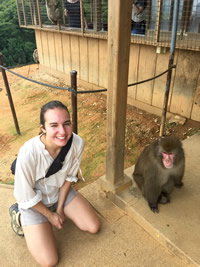
I visited the Arashiyama Monkey Park this weekend with Rebecca when all of the NanoJapaners were in town and made a new friend! He doesn’t look too thrilled to see me but trust me, he is…
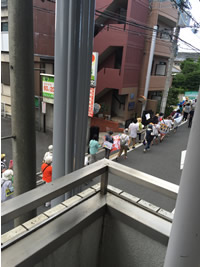
A demonstration that passed in front of my apartment chanting and waving signs. I’m still trying to figure out what their message was, but I have never seen this in Japan before!
Research Project Update
Last week, I completed characterizing the linear optical response of the our four different samples using the time-domain terahertz spectroscopy (TDTS) setup in the low-frequency range – from about 0.15 THz to 3 THz. I performed polarization-dependent measurements on the two aligned samples, and only one measurement each for the unaligned samples since the FTIR experiment confirmed that there is no decreasing trend in absorbance with increasing the angle to the alignment axis (as expected). The experimental output was the THz waveform amplitude in the time domain, so I used the Fast Fourier Transform (FFT) algorithm in Origin to obtain the magnitude in the frequency domain and calculate the transmission and absorption of the sample as I did during the FTIR experiment. I also learned how to generate the power spectrum of the signal using this algorithm, which will be useful in the nonlinear experiment for viewing the third harmonic generation (THG) we are hoping to observe. I then combined the data from the FTIR and TDTS experiments into a single plot to view the broadband spectrum for each sample.
I was pleased to find that the results aligned with our expectations. The absorbance in the mixed sample increased even further at the lower frequencies to approximately 0.5, and increased absorption by the free charge carriers in the metallic (6,6) sample could be viewed as well. Absorbance remained close to zero for the semiconducting samples – both aligned and unaligned – though the anisotropy of the response was still discernable. However, there is still a large gap in the spectra between ~0.01-0.1 THz where I do not have any data for the samples. Unfortunately, the lab’s alternate TDTS setup using air plasma THz generation is experiencing problems, so I am still trying to figure out a way to close this gap.
This system was the same one we had been planning to use for the nonlinear experiment. Fortunately, there is another setup in a different building, but we are facing another delay, as Arikawa-sensei has to work to optimize the signal in this setup as well. It wouldn’t be research without delays, right? We are expecting to begin data collection on Thursday, which doesn’t leave very much time at all for experimentation, so I think I will start bringing a sleeping bag to the lab next week so that I can analyze all of the data in time. J Fortunately, I have been using the down time to study the papers on harmonic generation that Kono-sensei gave me and I feel I am ready to go with a very solid understanding of the experiment. I have also made a lot of progress finalizing my abstract and my poster draft is essentially done except for the results of the nonlinear experiment, so I am still confident I will get everything finished.
Haruko Obokata was a young stem-cell biologist working at the RIKEN Center for Developmental Biology in Kobe. She became famous in January 2014 when she published two papers in Nature reporting on a phenomenon called“stimulus-triggered acquisition of pluripotency (STAP)”. Her findings were seemingly groundbreaking, however, other researchers had difficulty reproducing her results. Later, Dr. Obokata was found guilty for “scientific misconduct” and was accused of intentionally manipulating her data, plagiarizing and reusing old data and figures. Obokata was forced to retract her papers in the eyes of the public, but insisted that STAP cells were real and that she had created them at least 200 times. A few months later her supervisor committed suicide because he could not bear the shame the controversy had brought upon him. Obokata was given one final opportunity at RIKEN to replicate her STAP method under video surveillance, but was unable to do so by late December and was forced to halt her experiments. She resigned from RIKEN, and discussions about some serious fallacies in the Japanese and global research model commenced about image and data reuse, plagiarism, rush to publish, unhealthy competition, gift authorship and other issues.
Reading about the Obokata controversy was deeply unsettling. It’s shocking how quickly everything unraveled for the young scientist; in less than a year she went from being a respected researcher to a public disgrace with a dead colleague. Her controversy is a testament to the importance of ethics in scientific research. She clearly made some serious errors in judgment that she paid a heavy price for, and her colleague paid the ultimate price for her dishonesty. Frankly, I have no idea how she maintained the illusion for so long, and I think the whole thing is pretty twisted and strange. However, I also feel bad for her. As a young, female researcher in a male-dominated field, she was no doubt under incredible pressure to prove her worth and legitimacy. Japan has the lowest proportion of female scientists of the developed world at an alarming 14%. Sadly, this is a record high for Japan. For comparison, the United States was at roughly 33.6% in 2010. She was glorified as an icon for “rikejo”, young female scientists, and her discovery would have not only validated Japan’s role in the field but also showed that young women could succeed. Japan has experienced serious problems with underutilizing well-educated women, many of who leave the workforce to have families without returning.
Reporters have called Japan a “nation of housewives” and commented how women in Japan have arrived at a major crossroads. The number of women who are stay-at-home moms in their twenties who believe women should remain at home is rising according to the Ministry of Health, Labor and Welfare. Japan’s serious population problem means that the government needs to find a way to encourage women to work without sacrificing family life. Prime Minister Abe released a statement saying “Although the percentage of Japanese women completing higher education exceeds that of most other developed countries, their rate of participation in the labor force is low…what an enormous loss of talent.” He has also set an ambitious target for tripling the number of female managers in Japan to 30% by 2020. Many Japanese women do not think that women should have to retrieve special treatment to advance, but are frustrated as these kinds of ‘targets’ are the only way to force employers to act. And many still simply do not want to pursue a career. One young woman was quoted as saying “The government wants me to give birth, raise a child properly and work full time? Are they trying to kill me?".
As for my observations of sexism against female researchers in Japan, there haven’t been many. Fortunately, I haven’t witnessed any sexism firsthand against other women or myself as a visitor. There are only two female master’s students in our lab, and no female doctoral students. However, they are incredibly smart, capable researchers and it seems like everyone in the lab treats them as such. Naka-sensei, our Associate Professor, is the other female researcher in our lab who mentors many of the students and is clearly very highly respected. My only experiences with the sexism suffered by female researchers in Japan came indirectly when Naka-sensei kindly shared the history of her career with me last week.
As a female undergraduate researcher in the U.S., I’ve gotten no worse than condescending remarks here and there (although they do occasionally make me want to put my head through a wall). I am lucky to have had tremendously supportive teachers and mentors who have encouraged me to do research. I have also had the privilege of working in the lab of a female researcher who is not only a distinguished faculty member of the Aerospace Engineering Department, but a Dean. I think the critical difference between the U.S. and Japan is the amount of support and opportunities that young women have to pursue scientific research. While it definitely still needs improvement in both counties, I have seen that the situation is much more dire in Japan. Naka-sensei assured me that things are getting better, but it’s still alarming to me how many young women in Japan simply do not want to work because they feel they do not have any support and it has been instilled in them that being a housewife is their only serious option. There is absolutely nothing wrong with being a housewife, as long as it is a choice. A fundamental change in perspective is necessary both in Japan and in the U.S., along with the rest of the world. Women need to feel valued for more than their homemaking and their physical attributes, and we are doing something wrong if in the 21st century well-educated females in some of the most developed countries in the world are still being forced to choose between a job and a family because they do not have access to simple provisions like daycare. If we are not fully supporting a significant portion of our population, can we truly call ourselves developed?
Research Project Update
During this past week Arikawa-sensei and I have been working on the final experiment of this project investigating the nonlinear THz response of our four SWCNT samples. We are using the Tanaka group’s most complicated THz spectroscopy setup in a clean room that utilizes tilted-pulse-front excitation to produce the THz pulses with the strong electric field we need to observe nonlinear effects. This is a lengthy process for several reasons; first, the electro-optical microscope system that we are using to observe the pulse propagation is very sensitive. Arikawa-sensei needs to optimize the signal before each set of measurements, a process that is so difficult and requires so much experience that I mostly occupy the role of an observer, asking questions as often as I can without being insufferably annoying. Second, during our first ‘trial’ set of measurements we saw that it would be necessary to average approximately 100 measurements for each sample to obtain a power spectrum with minimal noise and frequency distortion.
This is relevant because the first peak in the spectrum we observed to be around ~0.8 THz, which means that we are looking for THG at ~2.4 THz; at this frequency, the intensity of the signal is weak and difficult to interpret, producing erratic absorption spectra for the samples as shown in Figure 1. Had there been clear evidence of THG the spectrum for the metallic (6,6) sample should have peaked below zero around 0.01 eV, but we did not observe this phenomenon.
After our results for the (6,5) and (6,6) samples were inconclusive, we moved on to the aligned, mixed SWCNT sample that has shown rather high absorption in the THz range in my previous linear response experiments. First, Arikawa-sensei took measurements parallel and perpendicular to the film’s alignment axis to verify the maximum signal (Figure 2). Arikawa-sensei then probed this sample twice, once with an added lens over the EO crystal to intensify the incident electric field and one without. When I computed the absorbance spectra from the resulting power spectra and plotted them alongside the linear spectra I obtained using the low-power TDTS system, we observed a curious phenomenon. As the incident field strength increased, the transmission of the sample increased with rapidly occurring induced transparency occurring around 1 THz. However, we again did not observe THG in this sample as the absorbance spectra at all field strengths remained positive. We performed one more experiment in which Arikawa-sensei added a silicon disc to the setup to attenuate the incident field strength to roughly halfway between the previous two measurements. While the resulting spectra did not fall exactly in between the spectra corresponding to 300 kV/cm and ~1 MV/cm, we still observed low absorption at this configuration and the same nonlinear behavior as the previous two trials (Figure 3).
We have not yet revisited the (6,6) and (6,5) samples to look for similar behavior in the purely metallic film with the semiconducting sample as a control sample. I will ask Arikawa-sensei about this tomorrow.
When I first came to Japan, I will admit despite my excitement I was a little nervous because I perceived Japanese culture to be very different from American culture. Although there are some critical differences, my experience helped me identify some key similarities between the two. My observations reaffirmed some of the notions I had from orientation, like the individualistic nature of American society versus the collectivist nature of Japanese society. However, I learned that Americans and Japanese are not so different in some ways that are easy to lose sight of. People are quick to identify the differences, but the reality is that both countries value hard work and initiative in different ways. Americans and Japanese are also both fiercely proud of their heritage and have a strong sense of identity. They are eager to reach new heights of excellence and create bright futures for their families and future generations. And, in this new era of internationalism, they are willing to create new connections and learn from each other.
My most common daily frustrations in Japan almost always revolved around communication. I have always been described as a very expressive person, and articulating my thoughts, feelings and desires has always come naturally to me. I am fairly direct, and in building relationships I love sharing ideas and bonding through conversation. Because of this, living in a country where I did not speak the native language kind of felt like chopping off my legs at first. I went from being able to advocate for myself readily to struggling to buy tissues in a 7-11. I often felt frustrated that I couldn’t accurately convey what I meant to say, and it was hard to make friends at first and make connections with my lab-mates when we were mutually afraid of embarrassing ourselves in the other’s language. I felt very lonely often, and I became a more quiet person as a result. However, I still made close and lasting friendships with my lab-mates, and even though I stumbled through a lot of daily interactions that I took for granted in the U.S. I got used to this and became a lot more resourceful in my means of communication. What I learned from these experiences is the importance of effort, the necessity of finding other means to connect across cultures and showing how much I cared about the people I spent my day with. I also learned the merits of learning to speak another language. This experience definitely changed me as a person; I am less impulsive, and I put more thought into my words and actions. I am more globally minded and compassionate to people from other cultural backgrounds. I am more independent and resilient, both personally and professionally. I am less timid and anxious about making mistakes or embarrassing myself. I now have the confidence that I can survive in new environments and be successful as a researcher in the future.
What I will miss the most about living and working in Japan is the sense of adventure I felt waking up every morning. On weekdays when I was headed to work, I was excited for the experiments I was going to perform that day, and being out of my comfort zone in a physics laboratory meant that I learned something new every single day. Never had I been given so much independence and accountability in a research project; it was incredible to feel like I was part of something so novel and interesting. I also loved how accessible and inviting Japan felt to me – Kyoto truly became my home, and I will miss how accessible various aspects of Japanese culture were to me when I wasn’t working. I will miss visiting temples and shrines that made me contemplate the nature of life, attending colorful and vibrant festivals and making new friends and memories every time I stepped outside. I will even miss being uncomfortable and making embarrassing language and cultural mistakes, because ultimately these shaped me as a person and provided me with a sense of growth and fulfillment.
This experience has solidified my desire to pursue my PhD and instilled a new passion for scientific research. It was incredibly valuable to gain insight towards life as a graduate student and the challenges and opportunities associated with a career in academic research. I am truly honored to have worked under the advisement of my mentors this summer and benefited enormously from their years of experience and expertise in the field. This experience has also made me determined to help close the gender gap in academic research in my future endeavors and laid the foundation for working in an international research team again in the future, perhaps while living outside of the United States.
My final week in the lab was a roller coaster of emotions. My lab mates threw me a going away party the Friday prior to my last week since many of them were going to be absent for summer school when I actually left. I was completely spoiled with homemade okonomiyaki and not one, but six gifts (Okahiro-san truly outdid himself as party planner). Arikawa-sensei even brought his ten-month-old daughter Riko-chan, who is absolutely adorable. My face hurt from smiling, and it was so much fun to bond with my lab mates and professors one last time before we all dispersed. I can’t possibly express the extent of my gratitude for all that they’ve done for me, but I wrote cards for my sensei and the lab mates I grew closest to. I also got them gifts and tried to let each of them l know how much I appreciate their guidance, support and friendship over these past 8 weeks.
Because of the challenges associated with collecting data for our final nonlinear experiment, mainly the complexity of the setup, the long operation time and the poor SNR ratio, we concluded experimentation following the measurements of the aligned, mixed SWCNT film. After that, I focused on finishing my poster and worked closely with Arikawa-sensei to identify key points for my presentation. Although I really enjoyed my research this summer, it is not likely that I will continue this project or spectroscopic research when I return to UMD. I will most likely continue to work in the engineering laboratories I am presently involved with, but with a renewed interest in nanomaterials and their optical properties. I do, however, plan on keeping in touch with my host lab and following their research endeavors.
For my final weekend in Japan, I climbed Fuji-san with all but four of the NanoJapaners! I can’t think of a better way to say goodbye to the beautiful landscape (among other things) that I’ve loved so much this summer. We began our climb Saturday night to catch the sunrise on Sunday morning. It was a much more challenging feat than we anticipated, especially after a week of no sleep as we all pushed to close out our internships - I slept for fourteen hours when we finally returned to Tokyo! However, it was definitely worth it. I’ll never forget what it was like to welcome the sun with a loud “OHAYOU GOZAIMASU” at the summit huddled in the cold with all of the other hikers.
It’s been a wild ride full of new challenges, knowledge, discovery, friendship and life-changing exploration. These 12 weeks in Japan have been the most fulfilling of my life. Thank you all so much for this incredible opportunity – I am so grateful, and I will cherish these memories forever. Question of the Week: when can I return?? :)
Research Project: ![]()
My NanoJapan project is entitled “Nonlinear Terahertz Responses of Single-Wall Carbon Nanotube Films”. I was hosted by the Solid State Spectroscopy Group led by Professor Koichiro Tanaka within the Department of Physics at the Kyoto University Graduate School of Science. My Japanese research mentor was Assistant Professor Takashi Arikawa, and my U.S. co-advisor was Professor Junichiro Kono of Rice University.
Single-wall carbon nanotubes (SWCNT) are essentially derived from rolling up graphene, sp2-hybridized carbon in a honeycomb lattice. Over the past decade they have shown incredible promise for optoelectronic applications with their unique, chirality-dependent electronic character and one-dimensional properties. Metallic nanotubes, for example, have a gapless, massless electronic dispersion like graphene. The linear optical properties of SWCNT have been extensively explored but their nonlinear optical properties have not been probed in low-energy regimes, particularly the terahertz (THz) region. The goal of this project was to investigate nonlinear optical responses of SWCNT films of different alignments and chirality compositions with the aim to observe phenomena such as third harmonic generation (THG), absorption saturation and induced transparency. The project offers new insights in fundamental 1D physics and has the potential to give rise to a new generation of highly efficient THz optoelectronics.
We characterized both the linear and nonlinear THz response of the SWCNT films. For the linear experiment, I utilized Fourier-transform infrared spectroscopy (FTIR) and time-domain THz spectroscopy (TDTS) to probe the films’ low-energy dynamics. This linear TDTS setup employed photoconductive antenna (PCA) THz generation. Conversely, we employed an alternate TDTS setup for the nonlinear experiment that produced large THz electric field pulses using the tilted-pulse-front technique, which matches the velocity of the THz beam and infrared pump beam to give rise to difference-frequency generation. In this setup, we also added a silicon lens over the sample and the LiNO3 electro-optical crystal to further intensify the incident electric field for subsequent measurements. I used Origin® software to perform transmission calculations and generate absorption spectra.
Drawing on recently published theory of third-order quantum behavior in the intraband dynamics of massless carriers in graphene, we were expecting to see strongly anisotropic nonlinear responses from the one-dimensional carriers in metallic SWCNT films because of their massless band structure. As expected, we observed strong nonlinear behavior in the aligned, mixed SWCNT film that contained metallic nanotubes, and we did not observe nonlinear responses in the semiconducting SWCNT films that lack free carriers. At ~1 THz the aligned, mixed SWCNT film exhibited rapidly onset induced transparency as transmission increased with incident electric field strength. A maximum transmission increase of 42.7% occurred a ~1 THz as the field strength was increased from 0.25 to 1.0 MV/cm using the techniques described previously. This behavior bears a phenomenological resemblance to recent studies of graphene in which transmission increased sharply and began to plateau at very high field strengths. Further investigation of this induced transparency phenomenon is necessary, particularly in SWCNT films enriched with purely metallic nanotubes, as we did not have sufficient time to attempt to replicate this response in the (6,6) sample.
NanoJapan has entirely changed my life. Writing this final report several weeks after leaving Japan, I still miss it terribly. My time in this program was truly surreal, and it has been difficult to re-adjust to life in the United States. Both of my parents have extensive international experience, so talking to them about my experiences helps a lot. I have told them that the most important things I learned from NanoJapan are independence, resilience and global mindfulness. I navigated an unfamiliar landscape, language and culture, lived alone for the first time, and encountered situations that precipitated personal growth – especially when I doubted myself. I learned how to keep a cool head when things went awry and became comfortable with being uncomfortable. Most importantly, I made new friendships and professional relationships that I will cherish forever.
If I were to speak to an employer about my experience, I would maintain these points but shift the focus a little bit. With regards to independence, I would share that I had the opportunity to dive into a challenging research topics, solve problems, conduct experiments and manage my own progress day-to-day (with exceptional mentorship of course), and this gave me confidence as a researcher because I now know I can function effectively as part of an international research team. With regards to resilience, I would probably tell them how I navigated setbacks such as broken equipment and unexpected delays with the help of my Japanese sensei and my US co-advisor. Finally, I would stress that this experience broadened my horizon, shaped my career goals and instilled a very strong desire to work internationally for the rest of my life. NanoJapan gave me adaptability in cross-cultural communication and lots of experience navigating cultural differences, so I feel I am well equipped for this. Before NanoJapan, I was passionate about international collaboration with regards to tackling research problems because I postulated that combining the perspectives and efforts of multiple nations invested in the problem would create the best possible solution. NanoJapan confirmed this for me, and showed me that as an American isolated from much of the world geographically and culturally I can overcome my limited perspective by learning as much as I can about my field from experts all over the world. Tanaka-sensei, Arikawa-sensei and Kono-sensei had so much knowledge to share with me, and I am forever grateful for their time and mentorship.
If I were to speak to a professor about my NanoJapan experience, I would emphasize the skills related to my field of study that I gained this summer. I would tell them that I had the opportunity to conduct terahertz research in the Solid State Spectroscopy Group at Kyoto U, where I learned how to perform various different spectroscopic techniques such as Fourier Transform Infrared Spectroscopy (FTIR) and time-domain terahertz spectroscopy (TDTS). I’d definitely give them a brief overview of the analytical techniques I used in Origin to obtain my results. I would also discuss how much I learned about the optical properties of single-wall carbon nanotubes (SWCNT) and the implications of our observation of induced transparency in SWCNT films with metallic nanotubes at high incident field strengths for optoelectronic applications. Finally, I would probably tell the story of the time Dr. Bob Curl came up to my poster at the Smalley-Curl Institute Summer Research Colloquium and shook my hand (still fangirling!) because that may be one of the coolest things ever to happen to me as a student of materials science.
Since returning to campus, I’ve gotten the question “How was Japan?!” about one hundred times so I’ve put a quite of bit of thought into how to share what I learned with my peers. When speaking with a student at my university about NanoJapan, I usually give them a very condensed/simplified version of what I researched and what I learned from my internship in the Solid State Spectroscopy Group. I also tell them how much fun I had learning Japanese and adapting to a society very different from my native one, and how much I learned about Japanese culture from my interactions with my new friends and senseis. However, I’ve found that it’s so hard to convey how much this experience meant to me in a casual conversation with a peer for many reasons. First, I could keep going for hours about Japan. Second, certain elements of what I experienced feel so sacred to me that it feels strange to just say “Yeah, the Buddhist temples were pretty cool” when actually I stood inside of a building that was over 1500 years old and pondered the universe. I miss my fellow NanoJapaners because they walked through Japan with me and probably share a lot of these feelings, but here in Maryland there aren’t a lot of people that can empathize.
Now that I’m back in the United States for a little while, I’m trying to seek out activities that keep me connected to my NanoJapan experience. I’m in the process of becoming an undergraduate member of the Japan America Society chapter in Washington D.C., and I hope to start taking language classes there this winter since I don’t have room in my university schedule. I’ve saved all of the tokens of my travels and keep them in my room so that I’m constantly reflecting on my adventures in Japan and hopefully continuing to grow from them. I’ve also taken all of the great resources provided to us in the re-entry program about applying to grad school and hit the ground running with researching programs I’d be interested in for the future. Although I’m still unsure about whether I’ll be able to go abroad again for research before I graduate, I am adamant about moving abroad long-term at some point in the next decade, hopefully as a post-doc. I’m also applying to a few universities outside of the U.S. for grad school, just to keep my options open. We’ll see what life has in store – after this incredible summer, I feel as though I can’t possibly explore enough of the world. As Leonardo da Vinci said, “Once you have tasted flight, you will forever walk the earth with your eyes turned skyward, for there you have been, and there you will always long to return.”
And, of course, I’m already saving up to go back to Japan.
Other Tips